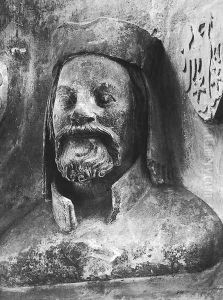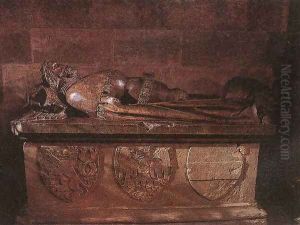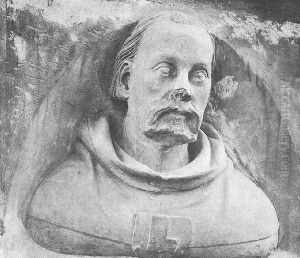Peter Parler Paintings
Peter Parler was a German architect and sculptor from the late Middle Ages, renowned for his contribution to Gothic architecture and sculpture. Born in 1330 in Schwäbisch Gmünd, Holy Roman Empire (present-day Germany), Parler hailed from a family of architects and builders, which greatly influenced his career path. His father, Heinrich Parler the Elder, was also a notable architect, suggesting that Peter's early exposure to the craft played a crucial role in shaping his skills and passion for architecture.
Parler's most significant work was on the St. Vitus Cathedral in Prague, Bohemia (now Czech Republic), where he served as the master builder from 1356 until his death in 1399. His work on the cathedral, particularly the choir and the vaulting, is acclaimed for its innovative approach to Gothic architecture, introducing new structural techniques and a unique aesthetic. Parler's designs incorporated complex vault systems and intricate tracery, which were not only structurally innovative but also visually stunning, marking a departure from the traditional Gothic style.
In addition to his architectural achievements, Peter Parler was also a talented sculptor. His sculptural works, including the busts of the Charles IV, Holy Roman Emperor, and members of the royal court, are among the earliest examples of portrait sculpture in Central Europe, showcasing a remarkable level of individuality and realism. These works are housed in the triforium of St. Vitus Cathedral, serving as a testament to Parler's skill in both architecture and sculpture.
Parler's influence extended beyond his own projects. He established a workshop that became a center for innovative Gothic architecture and sculpture, training a generation of architects and sculptors who would continue to develop the style across Europe. His sons, Wenzel Parler and Johann Parler the Younger, followed in his footsteps, contributing to the spread of his architectural ideas.
Peter Parler passed away in 1399 in Prague, leaving behind a legacy that would influence the development of Gothic architecture and sculpture for centuries. His innovative approach to design, mastery of form, and integration of sculpture into architectural spaces have earned him a place among the most significant architects and sculptors of the Middle Ages. Today, his work continues to be studied and admired for its creativity, technical skill, and aesthetic beauty.


